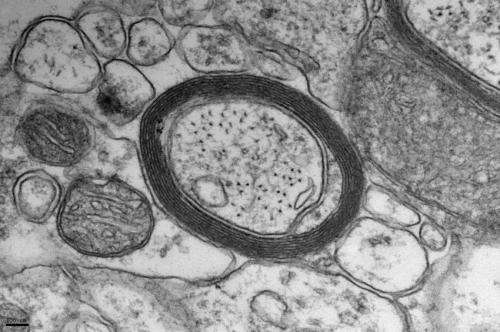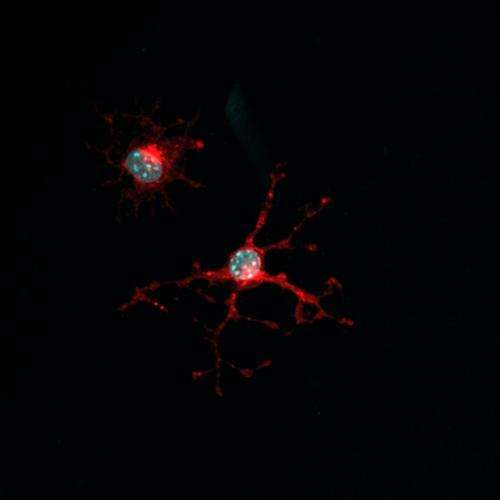Brain activity drives dynamic changes in neural fiber insulation

The brain is a wonderfully flexible and adaptive learning tool. For decades, researchers have known that this flexibility, called plasticity, comes from selective strengthening of well-used synapses—the connections between nerve cells.
Now, researchers at the Stanford University School of Medicine have demonstrated that brain plasticity also comes from another mechanism: activity-dependent changes in the cells that insulate neural fibers and make them more efficient. These cells form a specialized type of insulation called myelin.
"Myelin plasticity is a fascinating concept that may help to explain how the brain adapts in response to experience or training," said Michelle Monje, MD, PhD, assistant professor of neurology and neurological sciences.
The researchers' findings are described in a paper published online April 10 in Science Express.
"The findings illustrate a form of neural plasticity based in myelin, and future work on the molecular mechanisms responsible may ultimately shed light on a broad range of neurological and psychiatric diseases," said Monje, senior author of the paper. The lead authors of the study are Stanford postdoctoral scholar Erin Gibson, PhD, and graduate student David Purger.
Sending neural impulses quickly down a long nerve fiber requires insulation with myelin, which is formed by a cell called an oligodendrocyte that wraps itself around a neuron. Even small changes in the structure of this insulating sheath, such as changes in its thickness, can dramatically affect the speed of neural-impulse conduction. Demyelinating disorders, such as multiple sclerosis, attack these cells and degrade nerve transmission, especially over long distances.

Myelin-insulated nerve fibers make up the "white matter" of the brain, the vast tracts that connect one information-processing area of the brain to another. "If you think of the brain's infrastructure as a city, the white matter is like the roads, highways and freeways that connect one place to another," Monje said.
In the study, Monje and her colleagues showed that nerve activity prompts oligodendrocyte precursor cell proliferation and differentiation into myelin-forming oligodendrocytes. Neuronal activity also causes an increase in the thickness of the myelin sheaths within the active neural circuit, making signal transmission along the neural fiber more efficient. It's much like a system for improving traffic flow along roadways that are heavily used, Monje said. And as with a transportation system, improving the routes that are most productive makes the whole system more efficient.
In recent years, researchers have seen clues that nerve cell activity could promote the growth of myelin insulation. There have been studies that showed a correlation between experience and myelin dynamics, and studies of isolated cells in a dish suggesting a relationship between neuronal activity and myelination. But there has been no way to show that neuronal activity directly causes myelin changes in an intact brain. "You can't really implant an electrode in the brain to answer this question because the resulting injury changes the behavior of the cells," Monje said.
The solution was a relatively new and radical technique called optogenetics. Scientists insert genes for a light-sensitive ion channel into a specific group of neurons. Those neurons can be made to fire when exposed to particular wavelengths of light. In the study, Monje and her colleagues used mice with light-sensitive ion channels in an area of their brains that controls movement. The scientists could then turn on and off certain movement behaviors in the mice by turning on and off the light. Because the light diffuses from a source placed at the surface of the brain down to the neurons being studied, there was no need to insert a probe directly next to the neurons, which would have created an injury.
By directly stimulating the neurons with light, the researchers were able to show it was the activation of the neurons that prompted the myelin-forming cells to respond.
Further research could reveal exactly how activity promotes oligodendrocyte-precursor-cell proliferation and maturation, as well as dynamic changes in myelin. Such a molecular understanding could help researchers develop therapeutic strategies that promote myelin repair in diseases in which myelin is degraded, such as multiple sclerosis, the leukodystrophies and spinal cord injury.
"Conversely, when growth of these cells is dysregulated, how does that contribute to disease?" Monje said. One particular area of interest for her is a childhood brain cancer called diffuse intrinsic pontine glioma. The cancer, which usually strikes children between 5 and 9 years old and is inevitably fatal, occurs when the brain myelination that normally takes place as kids become more physically coordinated goes awry, and the brain cells grow out of control.
Other Stanford co-authors of the paper are Hannes Vogel, MD, professor of pathology and of pediatrics; Ben Barres, MD, PhD, professor and chair of neurobiology, as well as professor of developmental biology and of neurology and neurological sciences; postdoctoral scholar Bradley Zuchero, PhD; graduate students Christopher Mount, Grant Lin, Lauren Wood and Gregor Bieri; and undergraduate students Andrea Goldstein, Sarah Miller and Ingrid Inema.
More information: "Neuronal Activity Promotes Oligodendrogenesis and Adaptive Myelination in the Mammalian Brain," by E.M. Gibson et al. Science, 2014.

















